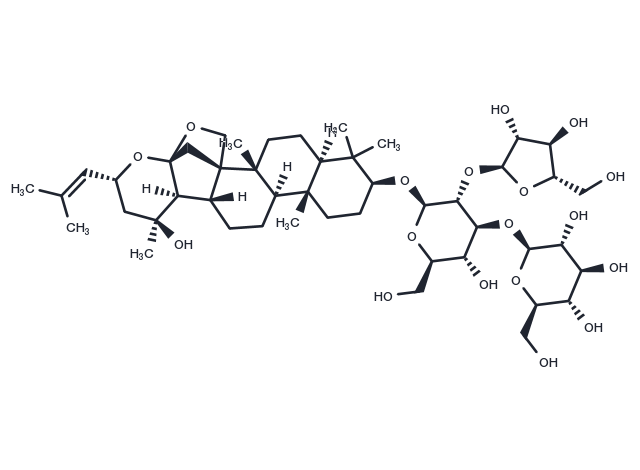Powder: -20°C for 3 years | In solvent: -80°C for 1 year


Bacoside A3 is one of the components of Bacopa monnieri (L.) Wettst. bacoside A with antioxidant potential. Bacoside A3 shows comparatively higher neuroprotective response analysed as higher cell viability and decreased intracellular ROS.

| Pack Size | Availability | Price/USD | Quantity |
|---|---|---|---|
| 1 mg | In stock | $ 68.00 | |
| 5 mg | In stock | $ 160.00 | |
| 10 mg | In stock | $ 235.00 | |
| 1 mL * 10 mM (in DMSO) | In stock | $ 268.00 |

| Description | Bacoside A3 is one of the components of Bacopa monnieri (L.) Wettst. bacoside A with antioxidant potential. Bacoside A3 shows comparatively higher neuroprotective response analysed as higher cell viability and decreased intracellular ROS. |
| In vitro | The cytoprotective effects of individual bacoside A components were evaluated towards oxidative stressed neuronal cells. Bacoside A was screened for neuronal cell viability (MTT assay) and change in intracellular reactive oxygen species (ROS), anti-apoptotic properties and mitochondrial membrane potential (MMP) using fluorescence microscopy. Different bacoside A components showed decrease in N2a cell viability below 100 (%) after bacoside A concentration of 0.4 mg/ml. Further, cytoprotective effect of optimized dose of bacoside A was analysed for alleviating oxidative stressed, apoptosis and MMP in H2 O2 stressed neuronal cells. Results showed increase in MMP, and decrease in apoptotic induction, without much change in nuclear integrity in stressed neuronal cells. Results showed Bacoside A3 and bacopaside II have comparatively higher cytoprotective ability whilst isomer of bacopasponin C, bacopasaponin C and mixture showed comparatively less response[1] |
| Source |
| Molecular Weight | 929.1 |
| Formula | C47H76O18 |
| CAS No. | 157408-08-7 |
Powder: -20°C for 3 years | In solvent: -80°C for 1 year
DMSO: 60 mg/mL (64.58 mM)
You can also refer to dose conversion for different animals. More
bottom
Please see Inhibitor Handling Instructions for more frequently ask questions. Topics include: how to prepare stock solutions, how to store products, and cautions on cell-based assays & animal experiments, etc.
Bacoside A3 157408-08-7 Immunology/Inflammation Membrane transporter/Ion channel Neuroscience ATPase ROS P-gp Inhibitor Bacoside A-3 Bacoside A 3 inhibit inhibitor
